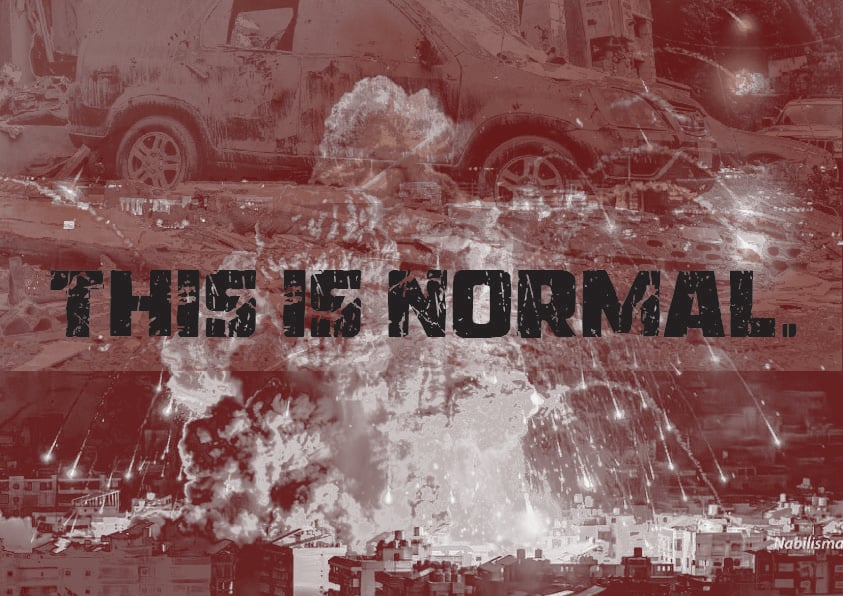Strategizing from 6 cities across the globe
Zionist Approval at the Price of Humanity
Journalism is the ultimate weapon in warfare. It is the tool which manufactures narratives and determines success. Whichever timeline you analyze, the media scheme is a battlefield for the dissemination of rhetoric and journalists are the soldiers who frame events and perpetuate impunity. Unfortunately, fairness and objectivity have only ever been ideals and claims.
WARJOURNALISMMIDDLE EAST
Selina G. Riachi
10/11/20246 min read


Just like physical warfare, this non-military face of war also depends on the domination of one side. In other words, the victor is the side who can best persuade the audience into believing that they are justified in war. Generally, the “West” - or the countries who imply economic and military power and leadership in international organization - tend to have increased global influence. This is mostly seen in diplomatic and political settings, but it is also very prominent in the media.
With the Israeli-Palestinian struggle and its spread into the MENA region, the population is consistently exposed to Western news channels’ version of events and their complicity in war. Considering these outlets’ unwavering pro-Zionist stance and their durable platforms, it is hard to escape their reach and prevent their impact. Western channels are known to uphold the “Subhuman” Arab and the “Victim” Israeli narratives, therefore enabling these perspectives to dominate news coverage. Through subtle and blatant techniques, immunity, and accountability, Western media have fueled Arab dehumanization.
To understand the post-October 7 reporting norms, one must study previous coverage. First and foremost, it is easy to notice the difference in the portrayal of Israelis and Palestinians. You are likely to observe heavy emphasis on the crimes perpetrated against Israelis and low reporting on the atrocities Arabs face. The Palestinians have greatly suffered from this misrepresentation in Western media. Any act of resistance on their part, even one as trivial as a child throwing a stone at Israeli troops, encounters cries of injustice and condemnation. However, stories highlighting their rebellion are met with diluted context as to why they are revolting. Moreover, the Palestinian issue was not a daily focal point in Western media except during active crises. Coverage was less consistent compared to other global issues, becoming a point of criticism from pro-Palestinian voices. Due to the Zionist framing of events, Palestinian suffering, occupation, and displacement rarely made the headlines they deserved for years. Such reporting led to huge gaps in the Western population’s understanding of the Israeli-Palestinian dynamic. It was so successful that significant amounts of people only exposed to Zionist media outlets were unaware of the 75 years of oppression the Palestinians experienced. They had no clue that the October 7 resistance was not an “unprovoked attack” but a buildup of years of frustration.
With the Israeli-Palestinian struggle at the forefront of newspapers, the narrative of the “Victim” Israeli had to be maintained. Western channels worked hard to “justify” Israel’s unproportionate response to October 7 by reporting false news. Who has not heard the “40 beheaded babies” claim and the “Hamas gang-rape” accusations? They became worldwide topics of discussion although being proven wrong – and to Israel’s advantage. Fabricating information so appealing and disgusting to people served its purpose in dehumanizing Palestinians and validating Israel’s severe attacks. In other words, who would feel sorry for child murderers or rapists? Furthermore, these narratives came with a reputation of Arab terrorism, savagery, and extremism, building the negative image of the Palestinians in people’s minds. With a bad first impression on 9/11 and continuous negative press, it is of no question as to why ill-exposed individuals remain in solidarity with Israel. Such false narratives enhance peoples’ already unyielding support of the Zionist entity.
If you compare the Israeli and the Palestinian/Arab sides featured in Western articles, you are bound to notice a striking contrast. In terms of pro-Zionist coverage, Israeli suffering is always prioritized and exaggerated. Facts which negatively represent Israel are often ignored, even when the uprising comes from within the state. For example, when interviewing newly freed Israeli hostages, multiple talked about how well they were treated by Hamas. However, Israeli officials either silenced them or forced them to uphold the victim image in front of the press. On the other hand, the Palestinian/Arab side looks different (in case it is featured for “objectivity”). If facts which can damage Israel’s reputation must be mentioned, they are twisted to be more acceptable. The power of language, specifically verbs, has continuously come into play to change the story, surely but discreetly. While Palestinians children and young girls have been referred to as “minors” and “women,” Israel’s teenagers/minors and women have been referred to as “children” and “girls.” While the Palestinians are “found dead,” Israelis are “massacred,” “slaughtered,” “murdered,” and “killed.” As seen, strong and active words are used to describe the pain Hamas inflicts on Israelis while extremely passive words are used to describe the murder of Palestinians. Western media use detailed words which enable readers to picture the tragic Israeli scene. But their reporting also implies the nonviolent and natural death of Palestinians at the hands of “no one.” This is how inaccurate labelling and less significant words manufacture tolerance and consent. These immoral techniques and nuances of language have become the main drivers of Israeli support.
Moreover, the visual portrayal of the Israelis and Palestinians in Western media differs tremendously. When Western media cover personal Israeli cases, they always show faces, smiles, and the lives of these citizens. They could display them sitting with their family, laughing, and acting like most people would. However, the Palestinians are pictured weeping in the midst of a warzone or without their faces shown. While this may seem like a way to appeal to the readers emotions and invoke compassion, it can also do the opposite. Israelis are given context and an identity. They are shown in happy pictures before delving into cases, inducing readers - especially those exposed only to Western media - to process that they are normal human beings who had ordinary lives before their country went to war. The thought “if this happened to a person who led a happy life, it can happen to me,” crosses these readers’ minds and they end up empathizing and even seeing themselves in these Israelis. However, the continuous photographs of the suffering Gazans with no context about their lives and no sense of identity is detrimental. Since no “other side” to the Palestinians is shown, readers get the impression that Palestinians are used to war and do not know anything else. They are not perceived as real individuals but as faceless victims or distant statistics. Palestinians become anonymous and dehumanized people experiencing a war they deserved and cannot win.
All these factors, from the inaccuracy to Palestinian misrepresentation, have dehumanized them in the Westerner’s perspective. With the spread of the war to Lebanese grounds came the generalization of the same Arab terrorist stereotypes. This is why double standards and hypocrisy have gone unnoticed regularly. For instance, the international community does not support Lebanon’s sovereign right to resist and defend itself from Israeli occupation. On the other hand, the Israelis, who are invading land which is not theirs, apparently “have the right to defend themselves.” Despite the uproar over Russia’s invasion of Ukraine, the invasion of South Lebanon is being reduced to a “limited ground operation.” Israel is even justified in its use of violence, as “sometimes you need military action to bring about diplomacy and de-escalation.” However, that only applies to Zionists! In addition, targeting Hamas and Hezbollah meeting areas located in civilian areas were met with accusations of the militias using citizens as human shields. Yet, targeting the Mossad Agency, which exists in a densely populated area in Tel Aviv, raised concerns about the civilians’ safety – and no allegations of Israel using them as human shields. Again, the use of language is evident when the Zionist enemies “attack,” “strike,” and “launch” missiles at Israel but the former’s land is passively “damaged” or subjected to “limited targeted incursions.” Other subtleties like keeping attacks in Beirut unattributed and specifying Israel’s targets as solely militias also serve to downplay the Zionists’ attacks and amplify their enemies’. Such erroneous reporting paired with the negative image of Arabs enhance Western revulsion to the Middle East.
In conclusion, there is an obvious dichotomy in the representation of the Israelis and the Palestinians/Arabs in Western media. It all goes back to ideologies and allies, but it remains inhumane. Western media have become more dangerous than ever, as they indoctrinate people and evoke false trust in the name of objectivity, accuracy, and credibility. As individuals (in the Middle East or Western countries) who follow less biased news and who have built a tolerance towards this propaganda, we must break Western media’s unassuming façade. Their readers must be educated about the extent of their impact and harm. By interacting with accurate news, correcting false information, and supporting minority views, we may be able to open less-exposed people’s eyes. As seekers of the truth, we must lead the revolution in the battlefield we call the media.
Design by Huda Khalili
References
Nuqul, S. (2023, November 15). Western media are partners in Israel’s genocide in Gaza. The New Arab.
https://www.newarab.com/opinion/western-media-are-partners-israels-genocide-gaza
Your words are your weapon - you are a soldier in a propaganda war. Al Jazeera Media Institute. (2024, April 21). https://institute.aljazeera.net/en/ajr/article/2642
Sara El-Yafi [@sarayafi]: “In contemporary history, the origins and escalation of nearly every war can be traced back to media lies.” Instagram, 13 July 2024, https://www.instagram.com/reel/C9XdKpDNLpA/?igsh=MWFzejB6ZDM2MnE3aw
